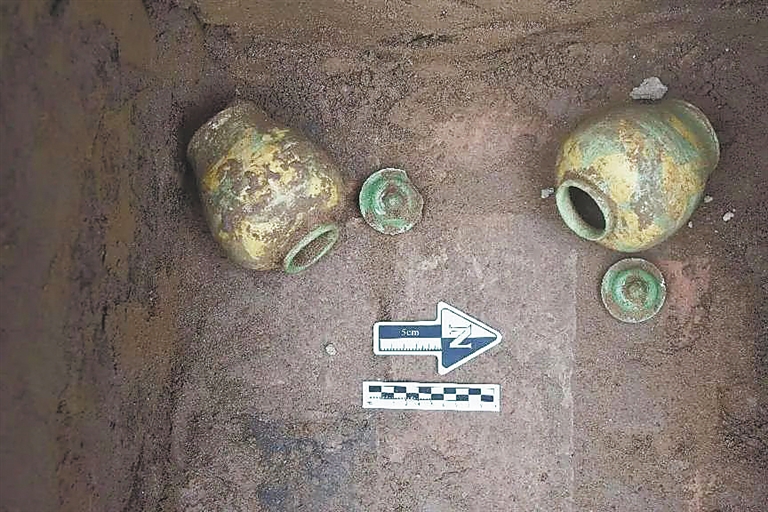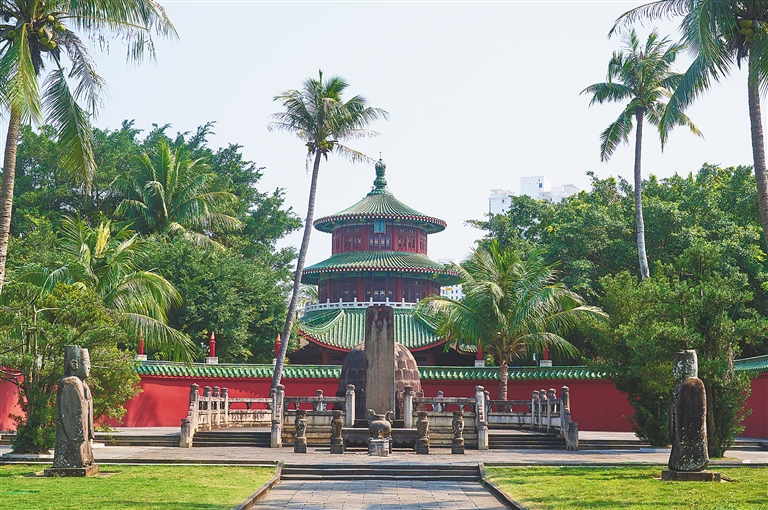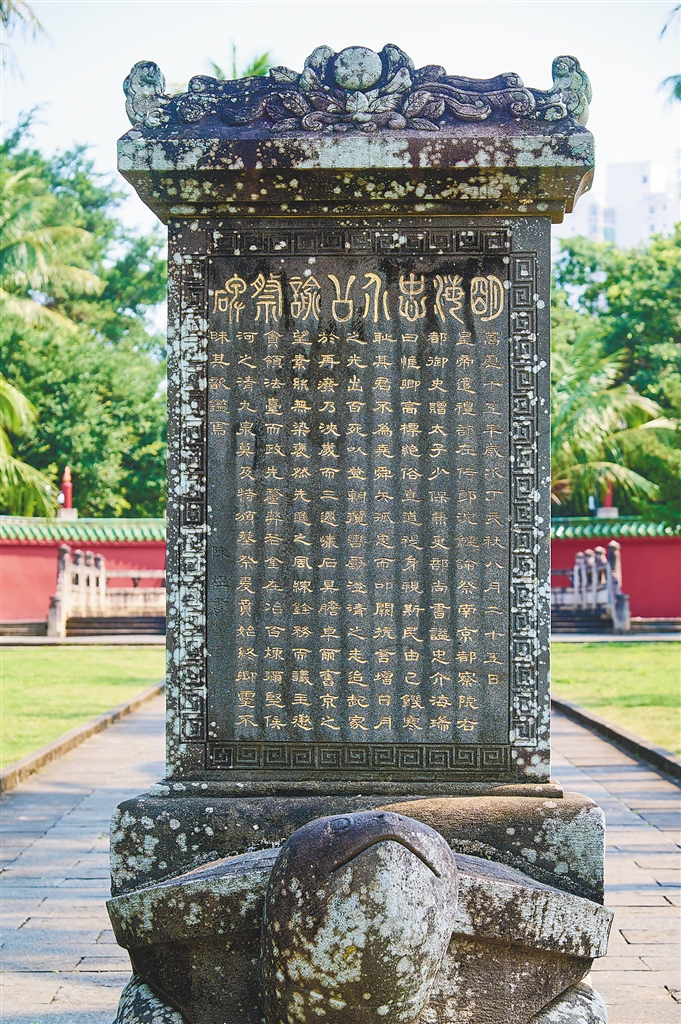
Source:HICN
It has long been known that funerals and burial culture are a microcosm of social development. As the largest grouping of historic tombs to have been discovered in Hainan, the recent publication by the Hainan Museum about the ongoing archaeological dig at Sanya’s so-called “Mountain of Graves” and the results so far, has once again aroused public interest in Hainan’s ancient past.

Lidded pottery jars unearthed recently at the “Mountain of Graves” Site in Sanya. (File photo)
Earliest Ancient Tombs Discovered So Far
According to statistics provided by cultural heritage departments, ancient burial sites uncovered in Hainan range from the prehistoric period to the Qing Dynasty. Of these, only two are prehistoric: the Qiaoshan Site in Lingshui and the Yingdun Site in Sanya.
In 2015, a joint archaeological team composed of members of the Institute of Archeology of the Chinese Academy of Social Sciences and people from the Hainan Museum carried out excavations at the Qiaoshan Site in Lingshui Li Autonomous County. At the time that this dig took place, it was the first prehistoric burial site to have been discovered in Hainan.

Qiaoshan Site tombs in Lingshui. (File photo)
Although the burials at the Qiaoshan Site are the earliest prehistoric tombs discovered in the province, they are not the oldest to have been discovered. Two years after work commenced at Qiaoshan, another ancient tomb was discovered in Sanya’s Tengqiao at the Yingdun Site. Making it the earliest tomb site to be discovered in Hainan, a preliminary analysis of the artifacts unearthed from the site has led experts to speculate that the area was in active use between 5,500 and 6,000 years ago. As with other prehistoric sites, unearthed human remains found here are providing experts with important information for the study of the DNA and physical characteristics of the Hainan's stone age residents.
Unique Tombs
During Han Dynasty Hainan, the most common type of tomb is presumed to have been the urn coffin type. The cultural heritage departments have reported five Han Dynasty urn coffin tombs in Hainan: Lingshui's Fuwan, Juntunpo and Mengpo sites, Baisha’s Zhizhen Site, and Sanya’s Fanlingpo Site.

Coral sarcophagus at the Fuwan Site in Lingshui. (File photo)
Urn coffins, which are a type of sarcophagus, have been found all over China dating as far back as Yangshao Culture (5,000 - 3,000 BCE) digs in the Central Plains area. Even now, pottery urns and urn covers are a common daily use item for many people around the world.
In ancient China, it was quite common for wealthier individuals’ coffins to be entombed inside sarcophagi. Hainan is unique in that—as far back as the 1970s—archaeologists have been finding burials using sarcophagi made of coral reefs that are widely distributed throughout Hainan's coastal waters (obviously, now that Hainan has enacted regulations to protect coral reefs for marine ecological conservation, coral is no longer used in this fashion). The first of these to be discovered were the Juntunpo Site tombs in Lingshui, followed by the tombs at Danzhou's Guangcun, Bochao, and Xinlong sites.

Carved coral figurine from a tomb in Lingshui. (File photo)
Embodiment of Cultural Exchange
After the Sui and Tang dynasties (581-907), the development of the Maritime Silk Road and the political demotion and exile of various officials to Hainan brought advanced culture to the island. At this time, Hainan’s burial culture was influenced by both Central Plains culture and foreign culture.
Both in Haikou, Hainan's best-known Tang Dynasty tombs are the tombs of Wu Xianxiu and his wife, and Wei Zhiyi and his wife.
Ranging from the Tang Dynasty (618-907) to the Yuan (1271-1368), Sanya and Linghsui both have a high concentration of vertical pit type Muslim tombs with finely carved tombstones. Lacking burial utensils or funerary objects, and located within the public cemetery, experts deduce that the persons interred within were most likely traders from Persia or the middle east who were passing through Hainan Island when they died. From this, it can be seen that the southeast coastal area of Hainan Island was an important fulcrum point of the ancient Maritime Silk Road.
Important Cultural Relics Unearthed from Ancient Tombs
In 1984, archaeologists working in Haikou excavated two Song Dynasty tombs located in Qiongshan District's Lincun Village. They unearthed grave goods ranging from altars to land purchase records.

A deed unearthed at the Lincun Village Site. (File photo)
Speaking of the ancient tombs in Hainan from which important cultural relics have been unearthed, it is necessary to mention the Tomb of Tao Gui (a Ming Dynasty military officer) in Haikou's Jinniuling Park. Much to archaeologists’ surprise, the tomb chamber contained a box with two pottery epitaphs. Entitled "The Life and Times of Tao Gui,” this rare inscription is more than 400 characters long.

Pottery Epitaph unearthed from the Tomb of Tao Gui. (File photo)
The excavation of Tao Gui's tomb was a great boon to scholars in terms of learning about Ming and Qing dynasty Hainan’s funerary systems. In particular, the discovery of the Tao Gui Epitaph provides a huge amount of previously unknown information on the layout of Hainan's Ming era military.
Imperial Class Tomb
As a form of preferential treatment bestowed by the emperor to some deceased relatives, and ministers of civil and military affairs, an imperial-class burial showed the emperor's affirmation and praise of the life achievements of the person within.
Dying in the 21st year of the Song Emperor Shaoxing (1151), the first person in Hainan to enjoy such treatment was Wang Juzheng, Vice Minister of War, Grand Secretary of the Hall of Literary Brilliance (Wenhuage), and Envoy of the Privy Council. During the Ming and Qing dynasties (1368-1912), a surprisingly large number of Hainanese officials were granted this right. For example—in the Ming Dynasty—Qiu Jun [Minster of Revenue and Grand Secretary of the Hall of Military Prowess (Wuyingdian)], Tang Zhou (Vice Minister of Revenue), and Hai Rui (Censor-in-chief of the Censorate) all received imperial-class burials. During the Qing Dynasty, Zhang Yuesong (who served as Provincial Administration Commissioner in Hubei) was also granted this right.
Among the known Ming Dynasty officials’ tombs in Hainan, Qiu Jun and Hai Rui have received the most attention as their very high standard tombs have a certain degree of similarity in construction including Spirit Ways flanked by stone statues, tombstones engraved with the characters “Burial Recognized by the Emperor” and ceremonial stone archways at the entrance.

The Tomb of Hai Rui. (Photo by Feng Shuo/Hainan Daily)

Monument at the Tomb of Hai Rui. (Photo by Feng Shuo/Hainan Daily)
Most known Ming Dynasty tombs in Hainan are stone tombs. Up through the Qing Dynasty, Hainan also had a distinctive “pagoda-type” tomb which has been found at the Antangshan (庵堂山) Site in Chengmai and the Xuanda Xianshi (玄达先师) Site in Qionghai. Serving as a demonstration of the early coexistence of multiculturalism on the island, the shape and style of these tombs and the inscriptions found on them make it obvious that they are directly related to the spread of Buddhism in Hainan.
Copyright The People's Government of Hainan Province. All Rights Reserved.
Approved by: General Office of Hainan Provincial People's Government.
Qiong ICP License No. 05000041-1
Government Website Identification Code: 4600000001
Qiong Computer Information Network International Internet Unit 46010802000004